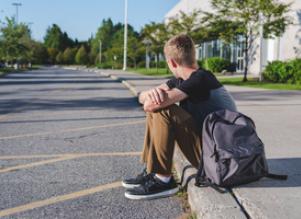10/3/2019
Student Homelessness: A Big Problem in the Nation’s Biggest Public School System
The challenges of growing up in this day and age range from the existential (figuring out who you are) to the comparatively trivial (choosing the perfect Snapchat filter). Although they shouldn't include housing instability, violence at home, or how to pay for lunch at school, such scenarios are an unfortunate reality for many kids facing homelessness.
In 2018, homelessness within New York Public Schools?—the largest public school system in the country?—hit a record high of 114,659, which equates to 1 in every 10 children living in temporary housing. Even more troubling is the fact that 2018 was the third consecutive year that homelessness in the city topped 100,000. Needless to say, this signifies a worrying trend, particularly as educators, social workers, and school officials have limited resources to draw upon as they struggle to combat the academic pitfalls that tend to accompany many of these students' inconsistent lifestyles.
Consistency is key
More specifically, nearly 60% of students who live in shelters and one-third of students in temporary housing are chronically absent, meaning that they miss at least 20 days of school in a single school year. The fact that some students may come to class one day and not be seen again for another two months—if at all—presents a pace-keeping challenge for educators. After all, when a student returns after missing significant amounts of class time, they are likely to tackle things a bit more slowly than their peers and may fall behind as a result.
In a piece for The New York Times, author Elizabeth Harris explained the dilemma faced by teachers in this type of situation: “Should they review material, and then review it again, so that the students who are in and out of their classrooms are not left too far behind? Or should they plow ahead so that the rest of the class can keep learning new things, and steal moments when they can to give the others a little extra help?”
Failing systems
Although the city's shelters are intended to assist families seeking a place to live, the application process can often compound the problem of chronic absenteeism; when applying for space in a shelter, parents are required to bring their children to prove their family’s makeup over the course of the 10-day application period, which causes these students to miss additional days in the classroom. Moreover, as there is no guarantee of obtaining a spot, many families have to go through the application process multiple times before securing housing.

Trouble at home
According to the Institute for Children, Poverty & Homelessness (ICPH), domestic violence is among the leading causes of homelessness in New York City, and “80% of homeless mothers with children have previously experienced domestic violence.” In children who witness acts of domestic violence, this stress may manifest into emotional and physical issues including depression, aggression, and struggles in school. After all, a child whose mind is clouded by worry over a parent's well-being or the threat of physical danger to themselves cannot be fully immersed in a lesson even when they are present in the classroom. This can create distance between student and teacher, as well as with peers whose lack of understanding and awareness of the situation may leave the child feeling isolated and unfocused.
The effects of gentrification
Lack of affordable housing is the leading cause of homelessness in New York City, with many families evicted from their homes as apartment buildings are rapidly replaced with luxury condos. What is a parent to do when their children still go to school near their old home but the family has been forced to move an hour away? Mary, a former Queens resident with a daughter and an autistic son who experienced this firsthand, told WNYC News that she was worried about her children losing the sense of stability and community provided by their school. “If you have any special-needs child, to keep them in what they’re comfortable in, their routines, especially when you’re dealing with anything on the autism spectrum, it’s really important,” she explained.
The road ahead
In an acknowledgment of the fact that homelessness is afflicting so many New York Public Schools students, New York City dedicated nearly $16 million to helping these students last year, predominantly in the form of special attention and an increased number of social workers available to schools with the highest rates of student homelessness. Although this investment increased from $10.3 million in 2016, the ratio of social workers to homeless students still leaves much to be desired, at approximately 1 of the former for every 1,660 of the latter.
Meanwhile, the Education Department’s Community Schools program targets high-need students and their families by supplying resources that will ostensibly yield more positive academic outcomes, including meals, access to Social Services, and advice for job-searching parents. The last few years have also seen increased pre-K enrollment and heightened yellow bus service for shelter-dwelling students. However, although Advocates for Children of New York noted that “the number of students who are homeless in New York City would fill Yankee Stadium twice,” support from local philanthropists in “arguably the philanthropic center of the world” seems to be missing.

